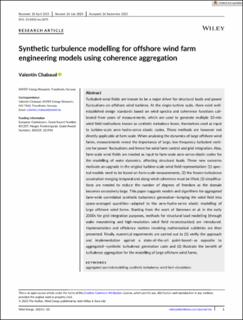| dc.contributor.author | Chabaud, Valentin Bruno | |
| dc.date.accessioned | 2024-01-03T14:24:42Z | |
| dc.date.available | 2024-01-03T14:24:42Z | |
| dc.date.created | 2023-12-19T14:07:26Z | |
| dc.date.issued | 2023 | |
| dc.identifier.issn | 1095-4244 | |
| dc.identifier.uri | https://hdl.handle.net/11250/3109605 | |
| dc.description.abstract | Turbulent wind fields are known to be a major driver for structural loads and power fluctuations on offshore wind turbines. At the single-turbine scale, there exist well-established design standards based on wind spectra and coherence functions calibrated from years of measurements, which are used to generate multiple 10-min wind field realisations known as synthetic turbulence boxes, themselves used as input to turbine-scale aero-hydro-servo elastic codes. These methods are however not directly applicable at farm scale. When analysing the dynamics of large offshore wind farms, measurements reveal the importance of large, low-frequency turbulent vortices for power fluctuations and hence for wind farm control and grid integration. Also, farm-scale wind fields are needed as input to farm-scale aero-servo-elastic codes for the modelling of wake dynamics, affecting structural loads. These new concerns motivate an upgrade in the original turbine-scale wind field representation: (1) spectral models need to be based on farm-scale measurements, (2) the frozen-turbulence assumption merging temporal and along-wind coherence must be lifted, (3) simplifications are needed to reduce the number of degrees of freedom as the domain becomes excessively large. This paper suggests models and algorithms for aggregated farm-wide corrrelated synthetic turbulence generation—lumping the wind field into space-averaged quantities—adapted to the aero-hydro-servo elastic modelling of large offshore wind farms. Starting from the work of Sørensen et al. in the early 2000s for grid integration purposes, methods for structural load modelling (through wake meandering and high-resolution wind field reconstruction) are introduced. Implementation and efficiency matters involving mathematical subtleties are then presented. Finally, numerical experiments are carried out to (1) verify the approach and implementation against a state-of-the-art point-based—as opposite to aggregated—synthetic turbulence generation code and (2) illustrate the benefit of turbulence aggregation for the modelling of large offshore wind farms. | en_US |
| dc.description.abstract | Synthetic turbulence modelling for offshore wind farm engineering models using coherence aggregation | en_US |
| dc.language.iso | eng | en_US |
| dc.publisher | Wiley | en_US |
| dc.rights | Navngivelse 4.0 Internasjonal | * |
| dc.rights.uri | http://creativecommons.org/licenses/by/4.0/deed.no | * |
| dc.title | Synthetic turbulence modelling for offshore wind farm engineering models using coherence aggregation | en_US |
| dc.title.alternative | Synthetic turbulence modelling for offshore wind farm engineering models using coherence aggregation | en_US |
| dc.type | Peer reviewed | en_US |
| dc.type | Journal article | en_US |
| dc.description.version | publishedVersion | en_US |
| dc.rights.holder | The Author | en_US |
| dc.source.journal | Wind Energy | en_US |
| dc.identifier.doi | 10.1002/we.2875 | |
| dc.identifier.cristin | 2215668 | |
| dc.relation.project | Norges forskningsråd: 321954 | en_US |
| dc.relation.project | Norges forskningsråd: 304229 | en_US |
| dc.relation.project | EC/H2020/851207 | en_US |
| cristin.ispublished | true | |
| cristin.fulltext | original | |
| cristin.qualitycode | 2 | |

